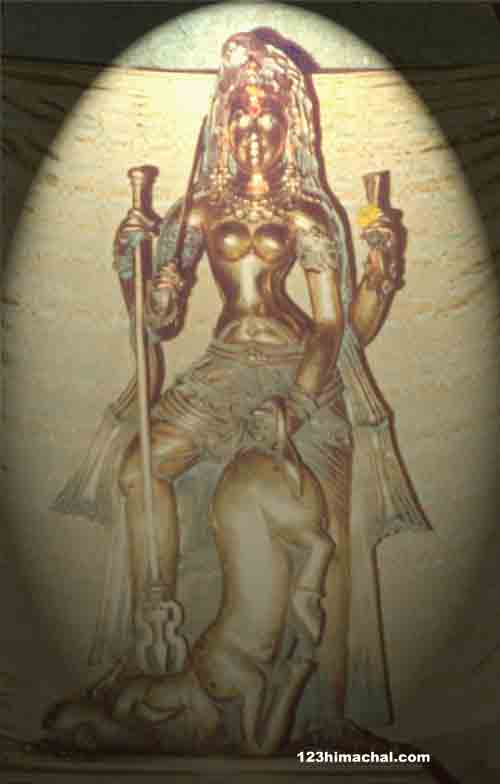|
Chamba can boast 0f three such temples adorned with the finest
wood-carving found in the north. They are the temples of Lakshana ,
at Brahmaur ; that of Shaktj, at
Chhatrahi; and that of Kali, at
Mirkula or
Udaipur in Lahul. It will be noticed that these three are all
dedicated to Devi. The Brahmaur and Chhatrarhi temples can be
approximately dated; for they contain brass images with inscriptions
which record their erection by Meru-varman, and on account of their
character may be assigned to about A. D. 700. I have little doubt
that the images are contemporaneous with the temples in which they
are enshrined. It should be remembered that the timber used for
these buildings is the wood of the Himalayan cedar or deodar (Cedrus
deodara) which, if well seasoned, is one of the most durable
timbers existing. The carvings which are exposed to the weather,
e. g., tbose on the facade of the Lakshana Temple, are now much
decayed, but wherever sheltered they exhibit an excellent state of
preservation. This point is especially conspicuous in the carved
capitals of tile Shakti temple.
Lakshana Temple
Bharmaur
 The
plan of the
Lakshana
Temple
differs from that described above, in that in front of the shrine we
find an ante-room, the two being enclosed within a solid wall of
rubble and wood masonry which has replaced the verandah. The facade
of this building is of particular interest, as in the style of its
decoration it exhibits a close affinity to the architecture of
Kashmir and Gandhara, and, indeed, shows traces of classical
influence peculiar to the monuments of the North- West. Under the
ridge-beam of the roof we notice first of all the triangular
pediment with the trefoil arch, a characteristic feature of the
Kashmir temples. The seated figure in the arch is not of Kali, as
supposed by Cunningham, but Surya the sun-god, as is evident from
the position of the legs. His twelve arms, holding various
attributes, are presumably indicative of the twelve months of the
year. The seven crouching figures along the basis of the triangle
probably represent t he seven days of the week . The
plan of the
Lakshana
Temple
differs from that described above, in that in front of the shrine we
find an ante-room, the two being enclosed within a solid wall of
rubble and wood masonry which has replaced the verandah. The facade
of this building is of particular interest, as in the style of its
decoration it exhibits a close affinity to the architecture of
Kashmir and Gandhara, and, indeed, shows traces of classical
influence peculiar to the monuments of the North- West. Under the
ridge-beam of the roof we notice first of all the triangular
pediment with the trefoil arch, a characteristic feature of the
Kashmir temples. The seated figure in the arch is not of Kali, as
supposed by Cunningham, but Surya the sun-god, as is evident from
the position of the legs. His twelve arms, holding various
attributes, are presumably indicative of the twelve months of the
year. The seven crouching figures along the basis of the triangle
probably represent t he seven days of the week .
Here, as well
as on the architraves between the pediment and the doorway, we find
an arrangement frequent in the Greco- Buddhist art 0f Gandhara; rows
of figures in arched niches, separated by dwarf pilasters. In the
lowermost row the figures are amatory couples which can be traced
back to Greco-Buddhist examples. We notice also a row of supporting,
crouching figures frequently met with in Gandhara sculpture and
corresponding to the Atlantes of classical art.
The
ornamentation on the lintels and jambs of the door-way is of a
purely Indian type. Over the entrance we find a double row of
garland-carrying flying figures, presumably meant for Gandharvas. In
the upper row each of these figures is accompanied by a female
figure seated on its hip. Along the jambs standing figures are
placed which are difficult to identify owing, to their decayed
state. On both sides of the threshold the river goddesses Ganga and
Yamuna (i. e. the Ganges and Jamna) are still recognizable, each
holding a water-vessel and a lotus-stalk. and standing on their
vehicles the crocodile (makara) and the tortoise. Finally I wish to
draw attention to the winged dragons rampant, which adorn the upper
corners of the door-way. |

